Brilliant ‘B’s: The Guide to 10 Popular Plants, Shrubs & Trees in Britain
From the majestic Beech to the butterfly-magnet Buddleja, explore our definitive guide to 10 popular plants, shrubs, and trees beginning with the letter B.
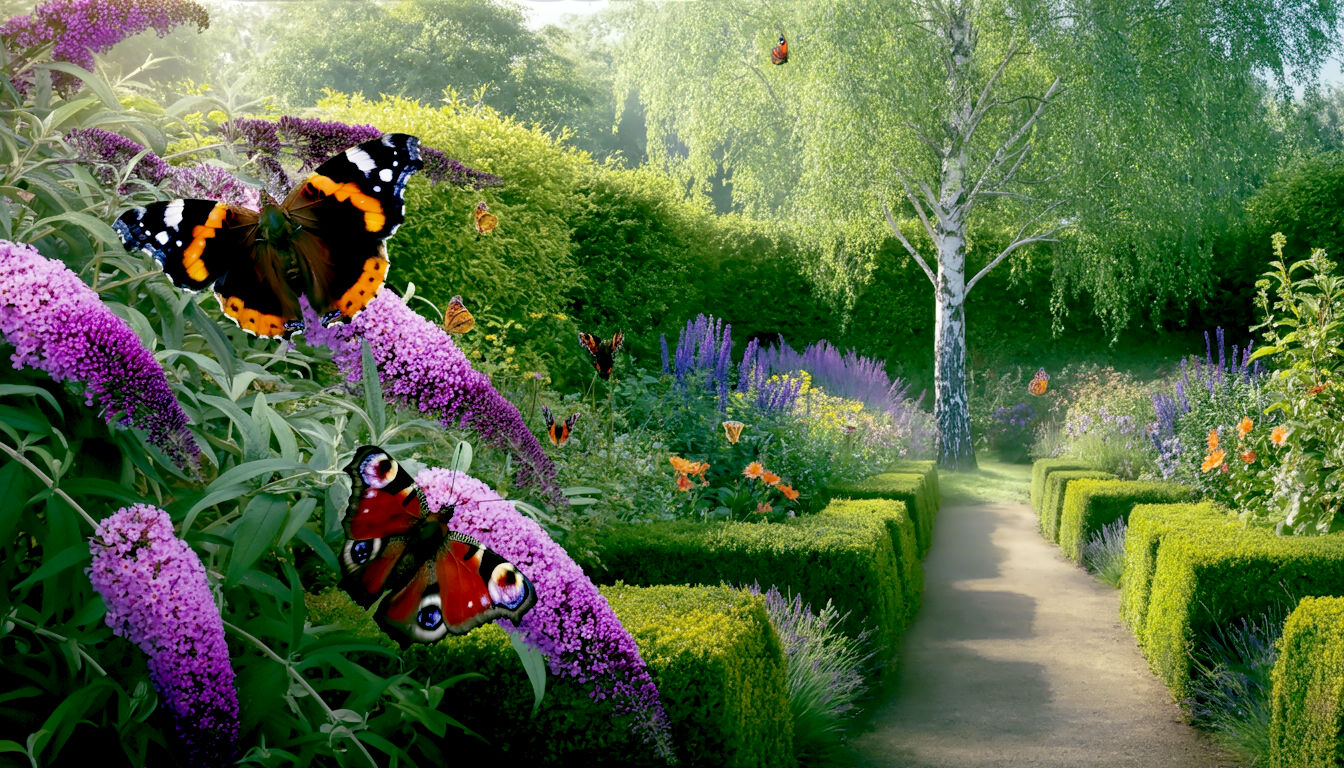
This post may contain affiliate links. If you make a purchase through these links, we may earn a commission at no additional cost to you.
From the backbone of our woodlands to the stars of our back gardens, the letter ‘B’ brings us some of Britain’s most beloved, beautiful, and downright useful plants. Whether you’re after a towering tree that’s a haven for wildlife, a shrub that brings all the butterflies to the yard, or a flower that adds a splash of colour to a shady corner, there’s a brilliant ‘B’ plant for you.
Think of this as your ultimate guide. We’re going to dig into ten of the most popular plants, shrubs, and trees that start with this brilliant letter. We’ll explore what they are, how they’ve shaped our landscape and culture, and, most importantly, how you can get them to thrive in your own patch of green. So, grab a trowel and a cuppa, and let’s get started.
1. Beech (Fagus sylvatica): The Majestic Native
If British woodlands have a queen, it’s surely the Common Beech. This magnificent tree, with its smooth, silver-grey bark and rustling leaves, defines many of our most beautiful landscapes, from the rolling Chilterns to the ancient forests of Scotland.
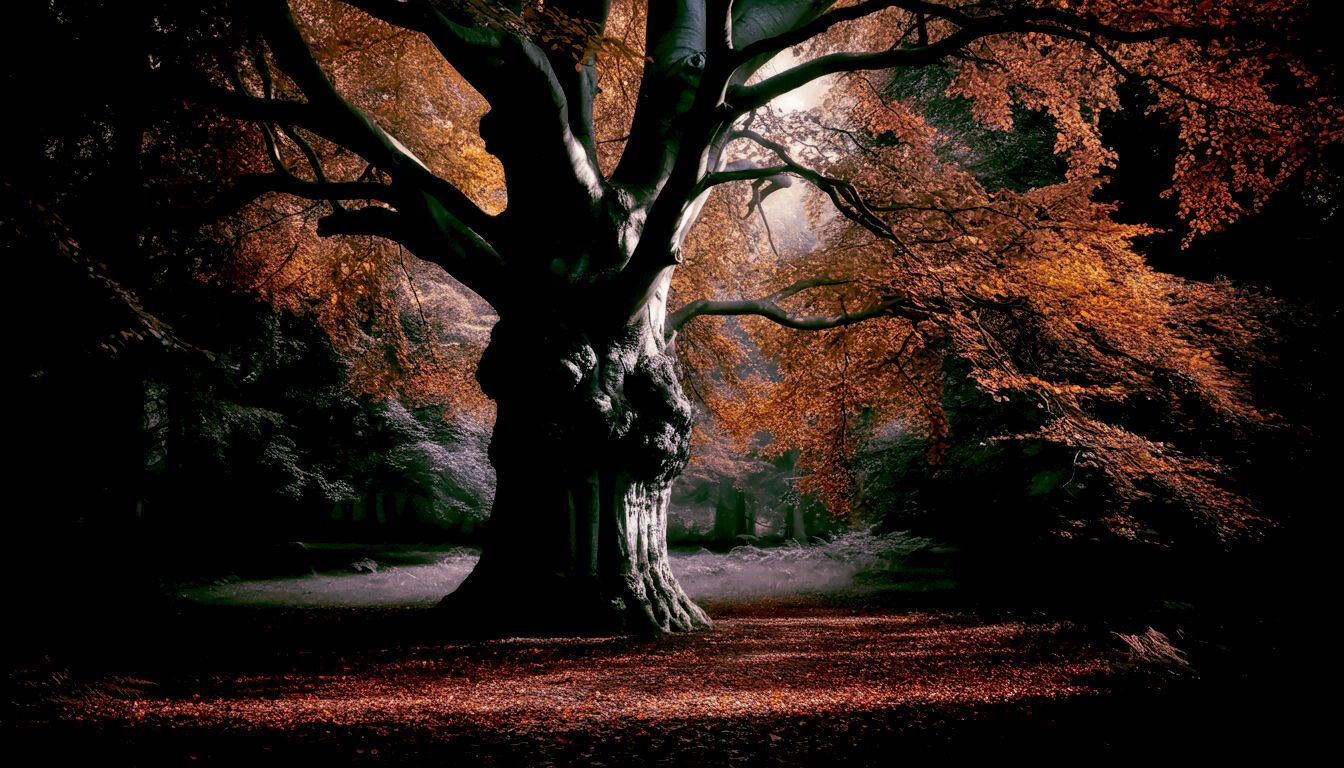
What is it?
Beech is a large, native deciduous tree that can grow over 40 metres tall and live for hundreds of years. Its bark is famously smooth, often tempting people to carve their initials into it (though it’s best not to!). In spring, its leaves unfurl in a stunning, almost luminous shade of green, fringed with soft, silky hairs. In autumn, they turn a glorious golden-bronze and often hang onto the branches right through winter, especially on hedges. This makes a Beech hedge a fantastic choice if you want a garden screen that gives you privacy all year round.
After mild autumns, Beech trees produce prickly, four-lobed cases that split open to reveal triangular nuts inside, known as ‘beechmast’.
A Bit of History and Folklore
Beech has been a part of Britain for thousands of years. Its timber is fine-grained and strong, making it perfect for furniture making—many a school chair and kitchen utensil has been crafted from beechwood. The famous furniture makers of High Wycombe built their reputation on the beechwoods of the Chiltern Hills.
Folklore says that Beech is the ‘mother of the woods’, offering protection and nourishment. Its nuts were once a vital food source for pigs, a practice known as ‘pannage’. Beechmast can be eaten by people too, but only in small amounts as they contain a mild toxin.
How to Grow it in Your Garden
You don’t need a massive estate to grow Beech. While a full-sized tree needs a lot of space, it takes beautifully to being clipped and is one of the best plants for hedging.
- Best spot: Beech likes well-drained soil and is happy in sun or partial shade. It’s not keen on heavy, waterlogged clay.
- Planting a hedge: The best time to plant a bare-root Beech hedge is from November to March. Plant your young trees (called ‘whips’) about 30-45cm apart.
- Care: Keep your new hedge well-watered for its first couple of years. Trim it once a year, usually in late August, to keep it neat and dense.
Popular UK Varieties to Try
- Fagus sylvatica: The classic green Beech, perfect for hedges or as a magnificent parkland tree.
- Fagus sylvatica ‘Purpurea’: The Copper or Purple Beech, which has stunning deep purple or reddish leaves that turn a coppery colour in autumn.
2. Birch (Betula): The Graceful Pioneer
With its slender trunk, peeling white bark, and delicate, fluttering leaves, the Birch tree is the supermodel of the tree world. It’s a pioneer species, one of the first to colonise open ground, bringing a touch of elegance to any setting.

What is it?
There are two main native Birch species in the UK: Silver Birch (Betula pendula) and Downy Birch (Betula pubescens). The Silver Birch is the one most people picture, with its striking white bark that peels off in papery strips and its weeping, delicate branches. Downy Birch has slightly less dramatic bark and a more upright shape, and it’s better suited to damp, boggy ground.
Birch trees are relatively small and fast-growing, making them perfect for modern, smaller gardens. Their light, airy canopy doesn’t cast heavy shade, so you can easily grow other plants underneath them.
A Bit of History and Folklore
Birch has always been a symbol of new beginnings and purification. Bundles of birch twigs were used in ancient rituals to drive out the spirits of the old year. It was also used to make maypoles for May Day celebrations.
Its waterproof bark was invaluable to early people, who used it for everything from roofing and canoes to writing paper. The wood is still used today for making plywood, and the sap can be tapped in spring to make a refreshing drink. In the wild, it’s a fantastic tree for wildlife, providing food and habitat for over 300 insect species, as well as birds like siskins and greenfinches.
How to Grow it in Your Garden
Birch is one of the easiest trees to grow. It’s not fussy and will bring light and beauty to your garden all year round.
- Best spot: Most birches love a sunny spot and will grow in almost any soil, as long as it isn’t waterlogged (unless you have a Downy Birch!).
- Planting: Plant container-grown or bare-root trees between autumn and spring. Make sure you stake the tree for its first year or two to protect it from strong winds.
- Care: Once established, Birch trees need very little looking after. They don’t need regular pruning; in fact, it’s best to just let them do their thing.
Popular UK Varieties to Try
- Betula pendula (Silver Birch): The classic choice, loved for its white bark and weeping habit.
- Betula utilis var. jacquemontii (Himalayan Birch): Famous for having the most brilliant, pure white bark of all. It looks incredible in winter.
- Betula pendula ‘Youngii’: A lovely weeping variety that forms a dome shape, ideal for tiny gardens.
3. Box (Buxus sempervirens): The Topiary Classic
Nothing says ‘classic British garden’ quite like a neatly clipped Box hedge. This slow-growing, evergreen shrub with its small, glossy, dark green leaves is the go-to plant for creating sharp, formal shapes, from low borders around rose beds to elaborate topiary peacocks.
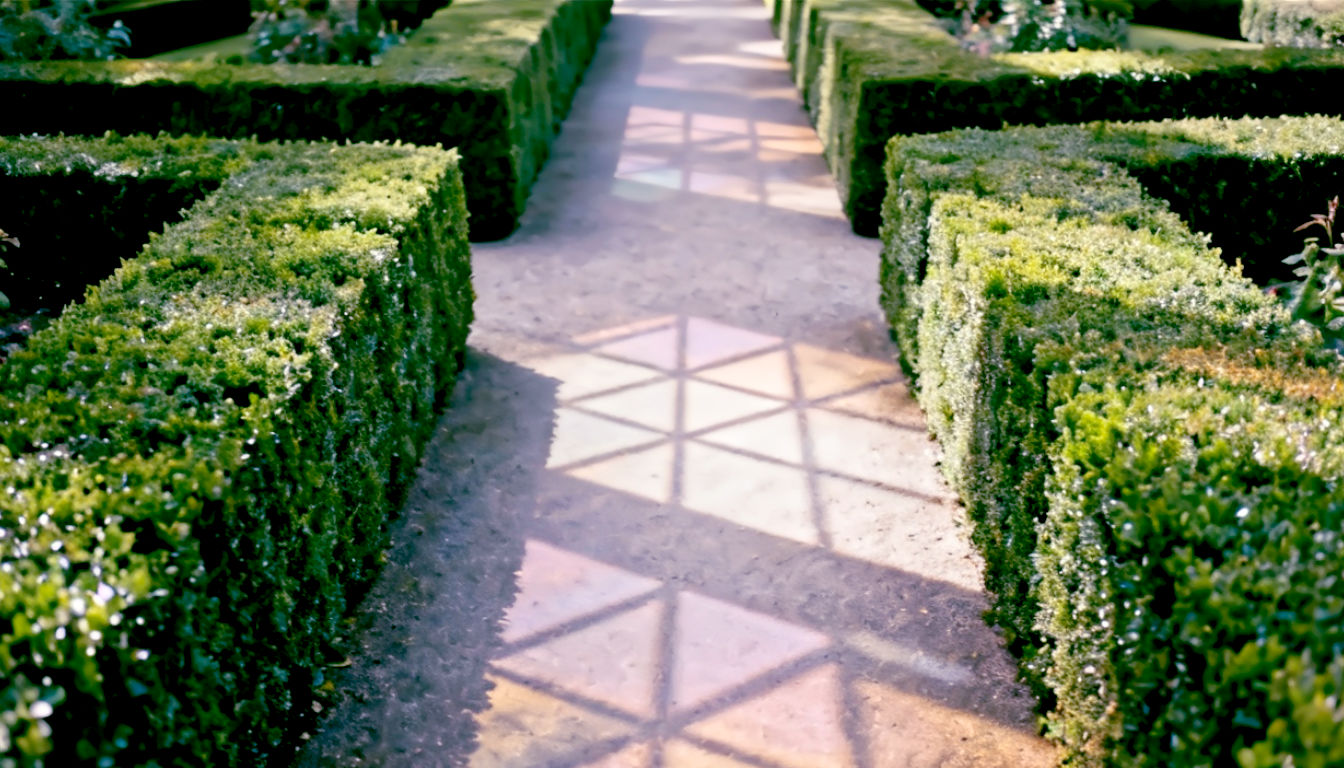
What is it?
Box is a native evergreen shrub or small tree. Left to its own devices, it can grow several metres tall, but it’s rarely seen in its natural state. Its true calling is to be clipped and shaped. Its dense foliage and slow growth make it the perfect plant for topiary and formal hedging. The leaves have a distinctive, slightly bitter smell, which becomes more noticeable after it’s been trimmed on a warm day.
A Bit of History and Folklore
Box has been used in formal gardens for centuries, dating back to Roman times. It became incredibly popular in Tudor knot gardens and later in the grand stately homes of the 17th and 18th centuries. Its wood is incredibly hard and dense (the word ‘box’ comes from the Latin buxus), making it ideal for detailed wood carvings and printing blocks.
How to Grow it in Your Garden
Growing Box successfully is all about getting the conditions right and keeping an eye out for a couple of nasty problems that have become common in recent years.
- Best spot: Box will grow almost anywhere, in sun or shade, and in most soils, as long as they aren’t waterlogged.
- Planting: Plant small, pot-grown plants about 15-20cm apart for a low hedge. Autumn is the ideal time.
- Care: The key to a great Box hedge is trimming. Clip it once or twice a year during the summer months (traditionally, around Derby Day in early June). Use sharp shears and try to trim on a cloudy day to avoid scorching the freshly cut leaves.
- Problems: Be warned, Box has two main enemies: box blight and the box tree caterpillar. Blight is a fungal disease that causes leaves to brown and fall off, while the caterpillar can strip a plant of its leaves in no time. Good air circulation and hygiene (clearing up fallen leaves) can help prevent blight. If you spot the caterpillars, you may need to use a biological control.
Popular UK Varieties to Try
- Buxus sempervirens: The common Box, great for general hedging and topiary.
- Buxus sempervirens ‘Suffruticosa’: A dwarf variety that is traditionally used for creating low, formal ‘parterre’ hedges.
4. Buddleja (Buddleja davidii): The Butterfly Magnet
If you want to fill your garden with fluttering wings, there is one shrub you absolutely must plant: Buddleja. Commonly known as the Butterfly Bush, its long, honey-scented flower spikes are an irresistible nectar bar for butterflies, bees, and other pollinators.
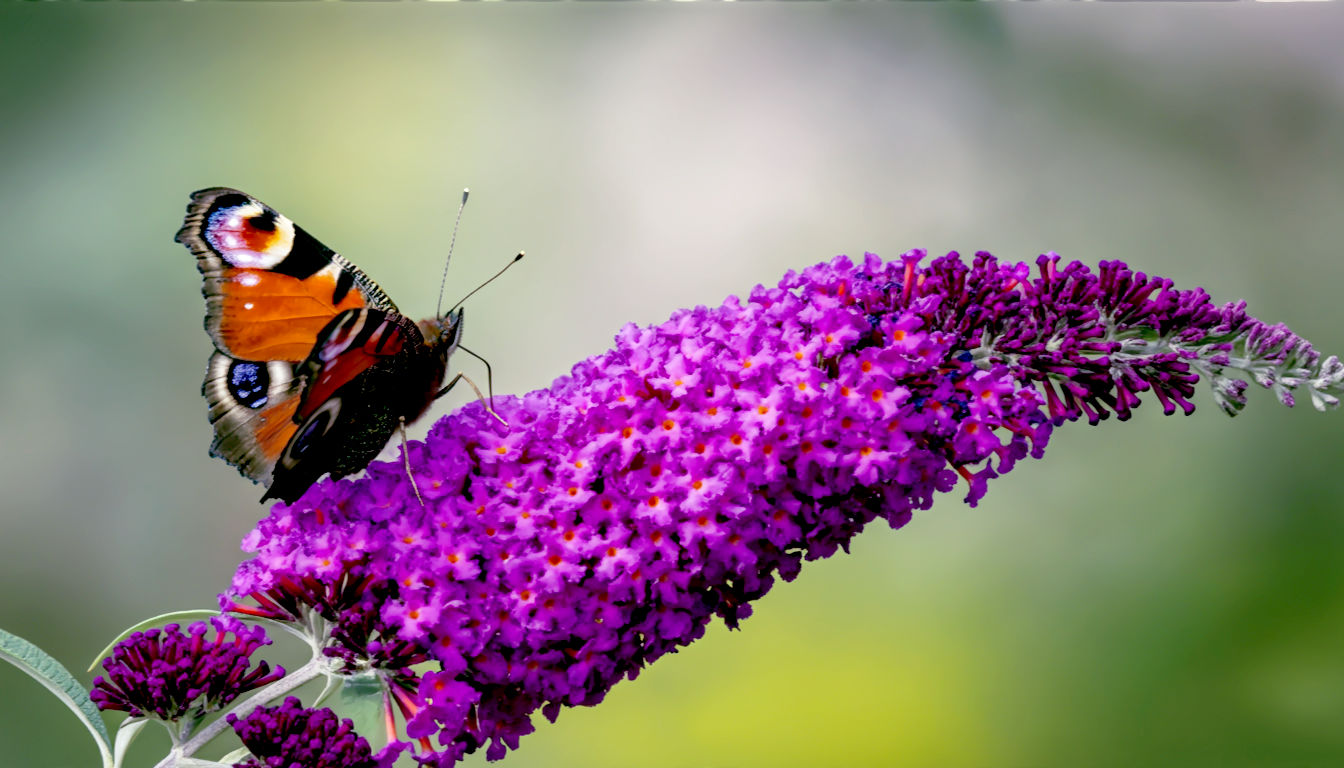
What is it?
Buddleja is a fast-growing, deciduous shrub that produces masses of flowers from summer through to autumn. The classic Buddleja davidii has long, arching stems and tapering flowerheads that come in shades of purple, lilac, pink, and white. It’s incredibly tough and can often be seen growing wild on railway embankments and wasteland, which has given it a bit of a reputation as a weed. But modern varieties are much more well-behaved and compact.
A Bit of History and Folklore
Buddleja davidii was introduced to the UK from China in the late 19th century. It’s named after two people: Reverend Adam Buddle, an English botanist, and Père Armand David, a French missionary who first discovered it. It quickly became a garden favourite because it was so easy to grow and so brilliant for wildlife.
How to Grow it in Your Garden
The secret to a happy, flower-filled Buddleja is sunshine and a good, hard prune.
- Best spot: It needs a spot in full sun to produce the best flowers. It’s not fussy about soil and will even grow in poor, dry conditions.
- Planting: Plant any time from autumn to spring.
- Care: This is the important bit! To keep the plant vigorous and covered in flowers, you need to prune it hard every year in early spring (around March). Cut all of the previous year’s growth back to a low framework, about 30-60cm from the ground. It looks brutal, but trust us, the plant will love it and reward you with masses of blooms on its new stems.
Popular UK Varieties to Try
- Buddleja davidii ‘Black Knight’: Has stunning, deep violet-purple flowers.
- Buddleja davidii ‘Royal Red’: Produces vibrant, magenta-red flowers.
- ‘Lo & Behold’ series: A range of modern, compact varieties like ‘Blue Chip Jr’ that are perfect for smaller gardens or pots and don’t seed everywhere.
5. Berberis (Barberry): The Prickly Protector
Looking for a shrub that’s tough, versatile, and offers great value all year round? Meet Berberis. With its colourful leaves, pretty spring flowers, autumn berries, and thorny stems, it’s a brilliant all-rounder that also doubles as a burglar-proof hedge.
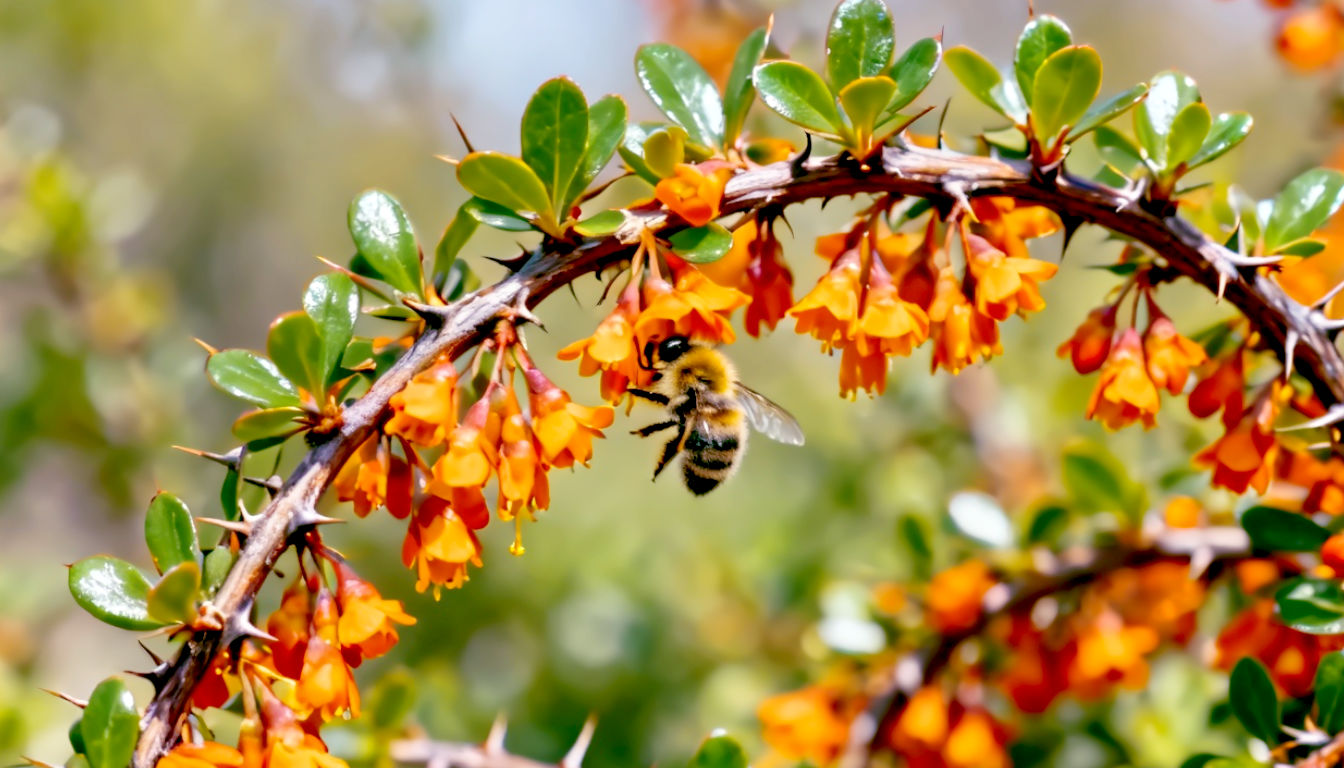
What is it?
Berberis, or Barberry, is a huge group of shrubs, containing both evergreen and deciduous species. They are best known for two things: their fierce thorns, which make them a fantastic barrier plant, and their often-spectacular foliage. Many varieties have vibrant leaves in shades of deep purple, fiery orange, or lime green.
In spring, they produce clusters of small, cup-shaped flowers, usually yellow or orange, which are a magnet for bees. These are followed by small berries in autumn, which birds love.
A Bit of History and Folklore
The berries of some Berberis species, like Berberis vulgaris, have been used for centuries to make jellies and jams. They are very sharp and rich in Vitamin C. The plant’s bark and roots also produce a yellow dye. Its sharp thorns have long made it a popular choice for planting along boundaries to keep livestock (and unwanted visitors) in or out.
How to Grow it in Your Garden
Berberis is one of the toughest and most reliable shrubs you can grow. It’s a great choice for beginner gardeners.
- Best spot: Most Berberis are happy in sun or partial shade and will grow in any reasonable, well-drained soil. The purple-leaved varieties have the best colour when grown in full sun.
- Planting: Plant pot-grown shrubs any time of year, but autumn and spring are best.
- Care: Berberis needs very little pruning. Just give it a light trim after it has finished flowering to keep it in shape and remove any dead or crossing branches. Remember to wear thick gloves—those thorns mean business!
Popular UK Varieties to Try
- Berberis darwinii: A fantastic evergreen with glossy, holly-like leaves and masses of bright orange flowers in spring.
- Berberis thunbergii ‘Atropurpurea’: A popular deciduous type with rich, deep purple leaves that turn brilliant red in autumn.
- Berberis thunbergii f. atropurpurea ‘Harlequin’: A deciduous variety with funky, purple leaves that are mottled with splashes of pink and white.
6. Begonia: The Colourful Bedding Star
For guaranteed, non-stop colour in your pots, hanging baskets, and borders all summer long, you can’t beat the brilliant Begonia. From fiery reds and oranges to delicate pinks and whites, they are the workhorses of summer bedding.
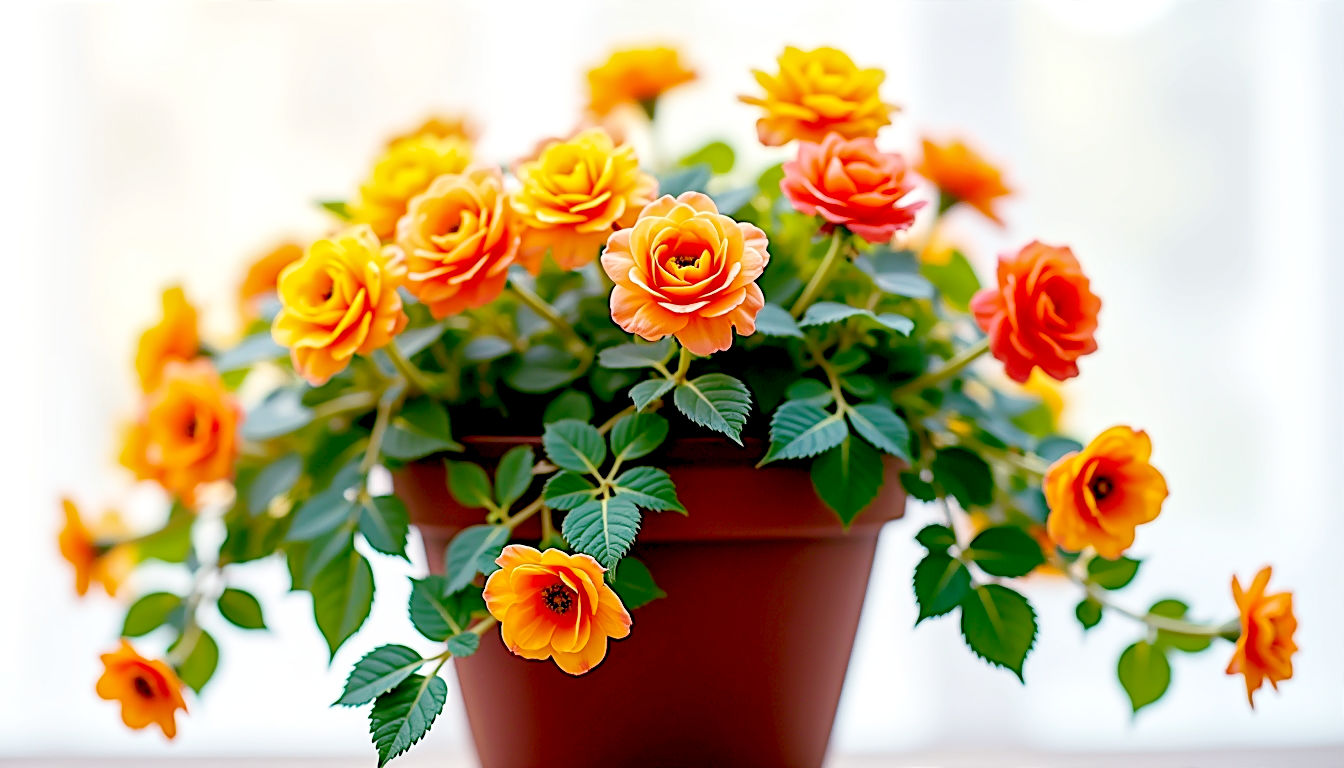
What is it?
Begonias are a massive group of plants, but the ones we use for summer bedding in the UK generally fall into two camps: tuberous Begonias and fibrous-rooted Begonias (often called wax Begonias).
Tuberous Begonias grow from a fleshy, potato-like tuber. They produce large, spectacular flowers, often resembling roses or carnations, and are perfect for hanging baskets and pots. Fibrous-rooted Begonias (Begonia semperflorens) are smaller, bushier plants with waxy leaves and masses of smaller flowers. They are brilliant for filling gaps in borders or for formal bedding displays in parks.
A Bit of History and Folklore
Begonias are native to tropical and subtropical regions. They are named after Michel Bégon, a 17th-century governor of a French colony in the Caribbean who was a keen plant collector. They became hugely popular with Victorian plant hunters and gardeners, who loved their exotic look and vibrant colours.
How to Grow it in Your Garden
Begonias are tender, meaning they can’t survive a British winter outdoors. But they are easy to grow for a stunning summer show.
- Best spot: Most Begonias prefer a spot in partial shade, as hot, direct sun can scorch their leaves and flowers. They need rich, moist, well-drained compost.
- Planting: You can buy small plug plants in spring, or buy tubers to start off yourself indoors in March. Don’t plant them outside until all risk of frost has passed, usually late May or early June.
- Care: Keep them well-watered, especially in hot weather, and feed them with a high-potash liquid feed (like tomato food) every couple of weeks to encourage more flowers. At the end of the season, you can lift the tubers, let them dry, and store them in a frost-free place to plant again next year.
Popular UK Varieties to Try
- Begonia ‘Non-stop’ series: A famous range of tuberous Begonias that, as the name suggests, flower their socks off all summer.
- Begonia ‘Illumination’ series: Trailing tuberous Begonias that are absolutely perfect for spilling out of hanging baskets.
- Begonia semperflorens ‘Organdy’: A popular fibrous-rooted mix for bedding, with a choice of green or bronze leaves.
7. Bellflower (Campanula): The Cottage Garden Charmer
With their pretty, bell-shaped flowers in shades of blue, purple, and white, Campanulas are the essence of a traditional British cottage garden. They are easy-going, beautiful, and come in a huge range of shapes and sizes.
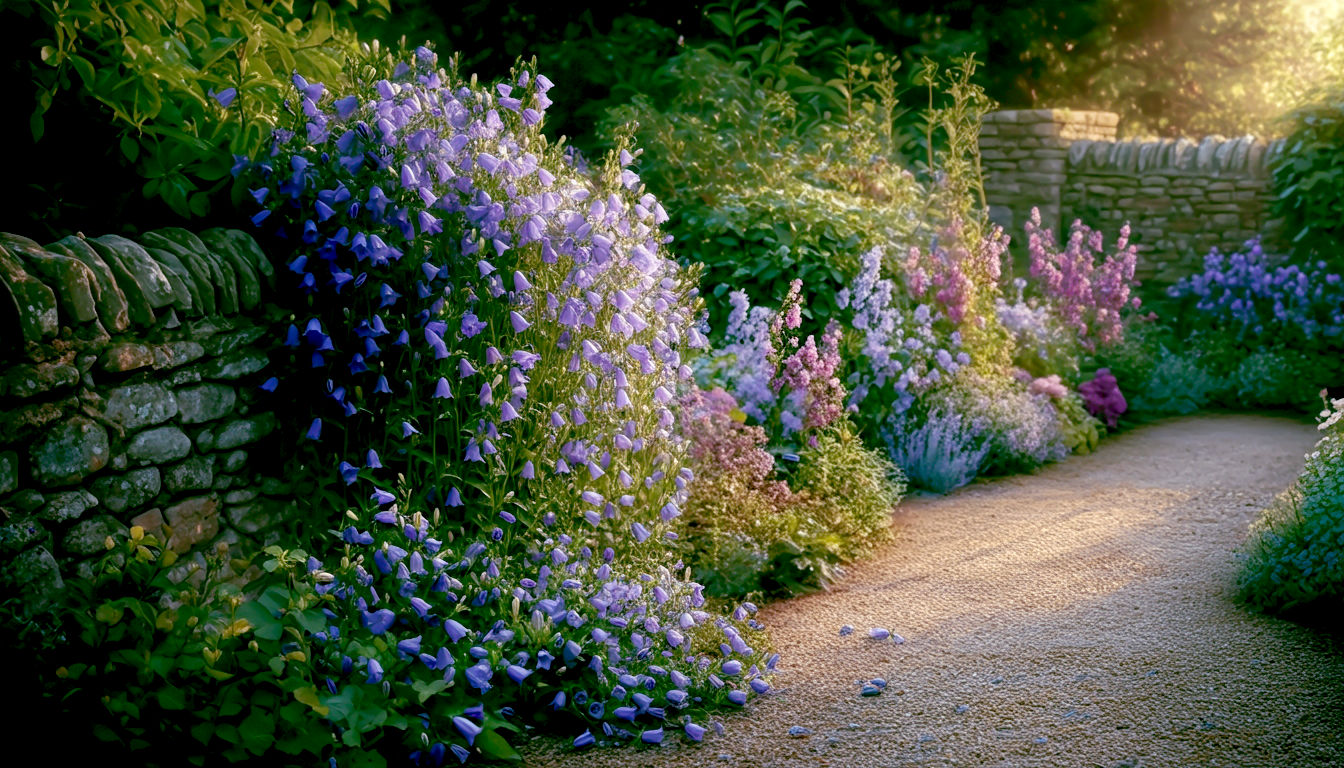
What is it?
Campanula is a huge family of plants, all sharing the characteristic bell- or star-shaped flower. They range from tiny, creeping alpine plants that are perfect for rock gardens, to tall, stately border perennials. Some of the most popular types are Campanula portenschlagiana (wall bellflower), a low-growing evergreen that will happily grow in cracks in walls, and Campanula persicifolia (peach-leaved bellflower), which has tall spires of elegant, cup-shaped flowers. Our native Harebell (Campanula rotundifolia) is also a type of bellflower.
A Bit of History and Folklore
The name Campanula is Latin for ‘little bell’. In the language of flowers, they represent gratitude and everlasting love. Many species are native to Europe and have been grown in British gardens for centuries. They are a classic, reliable choice that never goes out of fashion.
How to Grow it in Your Garden
There’s a Campanula for almost every situation, which is why they are so popular.
- Best spot: Most prefer full sun or light shade and well-drained soil. The alpine types are particularly good in gravel gardens or spilling over walls.
- Planting: Plant perennial Campanulas in spring or autumn.
- Care: They are generally low-maintenance. Taller varieties may need staking to stop them flopping over. The most important job is to deadhead them regularly by snipping off the faded flowers. This will encourage them to produce more blooms and can often result in a second flush of flowers later in the summer.
Popular UK Varieties to Try
- Campanula portenschlagiana: An unstoppable, mat-forming evergreen that produces a sea of violet-blue bells. Perfect for the front of a border or tumbling over a wall.
- Campanula lactiflora ‘Loddon Anna’: A tall, elegant border plant with beautiful, milky-pink bellflowers.
- Campanula ‘Birch Hybrid’: A popular low-growing variety with masses of violet-blue, star-shaped flowers.
8. Bergenia (Elephant’s Ears): The Tough All-Rounder
If you’re looking for a plant that will grow almost anywhere, look fantastic all year, and require virtually no effort, then you need some Bergenia in your life. Nicknamed Elephant’s Ears for its large, leathery, rounded leaves, this is one of the toughest plants you can find.
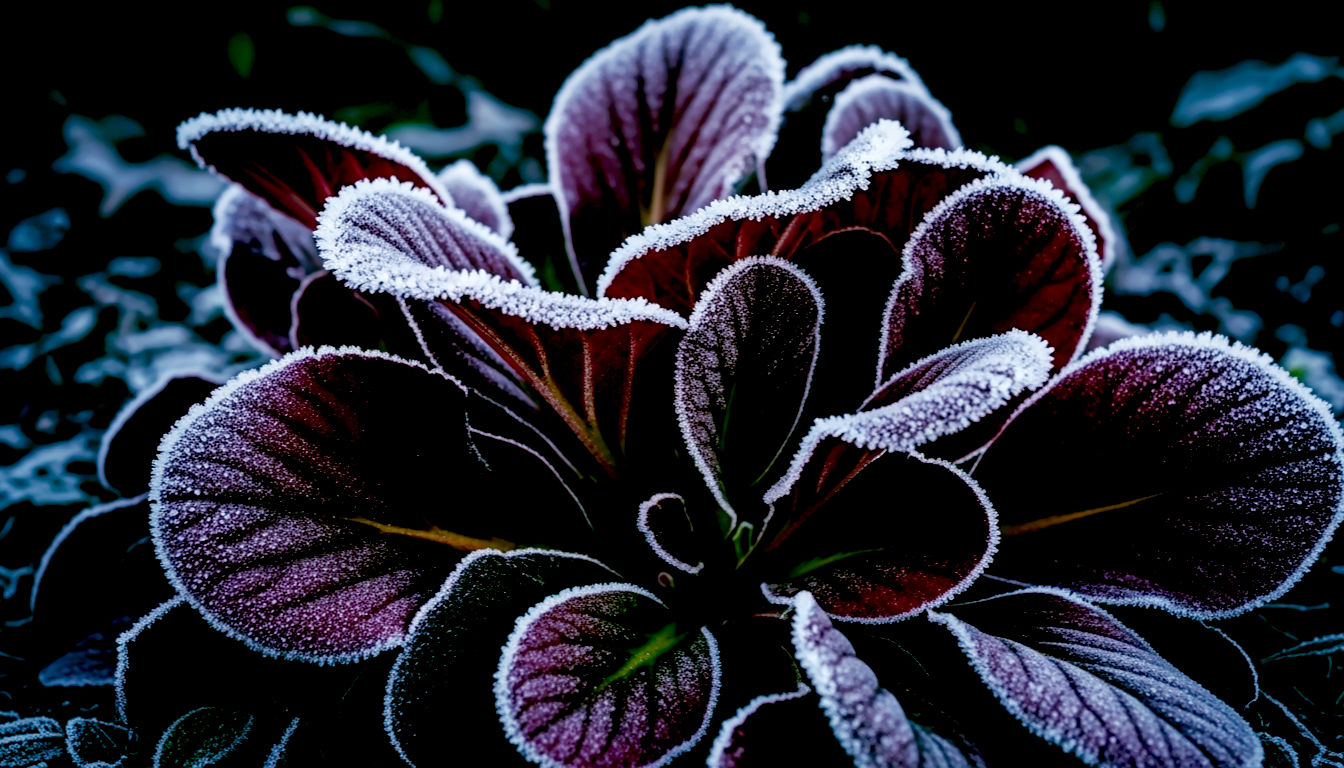
What is it?
Bergenia is a hardy, evergreen perennial that forms clumps of large, glossy leaves. It’s a brilliant ground cover plant, especially for tricky spots like dry shade under trees. The leaves are its main feature, providing bold texture, but in spring it also sends up sturdy stems of pink, magenta, or white flowers. As a bonus, the leaves of many varieties turn wonderful shades of deep red and purple in the winter, adding a splash of colour when the garden can be a bit bare.
A Bit of History and Folklore
Bergenias originate from Central and East Asia. They are named after the German botanist Karl August von Bergen. They became popular in the UK as they are so resilient and reliable, able to cope with our cold, wet winters and occasional dry summers. The plant also got another nickname, ‘Pig Squeak’, because of the sound the leaves make when you rub them between your fingers.
How to Grow it in Your Garden
It’s almost harder to kill a Bergenia than to grow one. They are incredibly forgiving.
- Best spot: They will grow pretty much anywhere—sun, shade, good soil, poor soil. They will even tolerate dry conditions once they are established. For the best winter leaf colour, plant them in a sunny spot in poorer soil.
- Planting: Plant in spring or autumn.
- Care: Bergenias are the definition of low-maintenance. The only job you really need to do is to tidy up any tatty-looking old leaves in the spring to make way for the new growth. You can also snip off the flower stalks once they have finished.
Popular UK Varieties to Try
- Bergenia ‘Bressingham Ruby’: A great variety with deep ruby-red winter foliage and bright magenta flowers.
- Bergenia cordifolia ‘Purpurea’: A classic, tough-as-old-boots variety with large green leaves that turn purple in winter.
- Bergenia ‘Overture’: Known for its fantastic display of bright magenta-pink flowers held high on red stems.
9. Broom (Cytisus): The Golden Wonder
For a spectacular burst of colour in late spring, few shrubs can compete with the Common Broom. Its arching stems become completely smothered in masses of small, pea-like flowers, creating a cascade of brilliant yellow that lights up the garden.
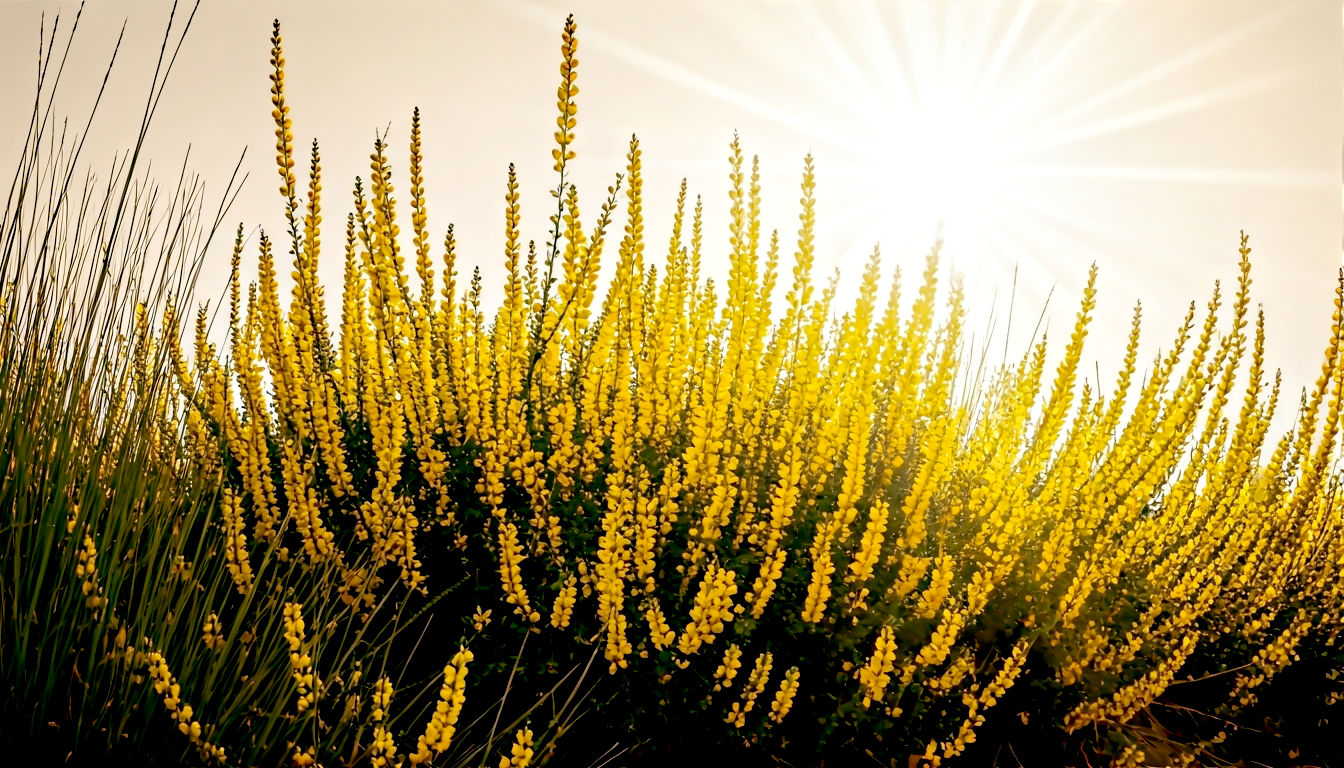
What is it?
Broom is a fast-growing deciduous shrub. The most common type grown in gardens is Cytisus, which is related to our native Broom (Cytisus scoparius) that you see growing on heaths and commons. They have tiny leaves on green, rush-like stems, which means the plant looks green and interesting even in winter. But it’s the flowers they are grown for. While yellow is the classic colour, modern hybrids come in a range of fiery shades, including red, orange, pink, and cream.
A Bit of History and Folklore
The name ‘Broom’ comes from the fact that its long, wiry stems were traditionally tied together to make brushes for sweeping. It’s also the origin of the Plantagenet royal dynasty’s name; they took their name from the Latin for Broom, planta genista, a sprig of which their founder, Geoffrey of Anjou, wore in his hat.
How to Grow it in Your Garden
Broom loves sun and hates being fussed over, making it ideal for a low-maintenance, sunny spot.
- Best spot: It absolutely must have full sun and very well-drained, poor soil. It will not tolerate rich or waterlogged conditions. This makes it perfect for a dry, sunny bank or a gravel garden.
- Planting: Brooms hate having their roots disturbed, so always buy pot-grown plants and plant them in their final position. Spring is the best time to plant.
- Care: Pruning is key to keeping a Broom plant compact and long-lived. Trim the flowered stems back by about half immediately after they have finished flowering. Don’t cut back into the old, brown, woody part of the plant, as it won’t regrow from there.
Popular UK Varieties to Try
- Cytisus ‘Boskoop Ruby’: A stunning variety with deep, ruby-red flowers.
- Cytisus × praecox ‘Allgold’: One of the best for pure, brilliant yellow flowers.
- Cytisus ‘Hollandia’: A very popular variety with flowers in a beautiful mix of pink, lilac, and cream.
10. Blackthorn (Prunus spinosa): The Wild Forager’s Friend
Our final ‘B’ is a true native, a rugged, thorny shrub or small tree that is the essence of the British hedgerow. Blackthorn might be wild and spiky, but it’s beautiful in spring and gives us one of autumn’s greatest boozy treats.
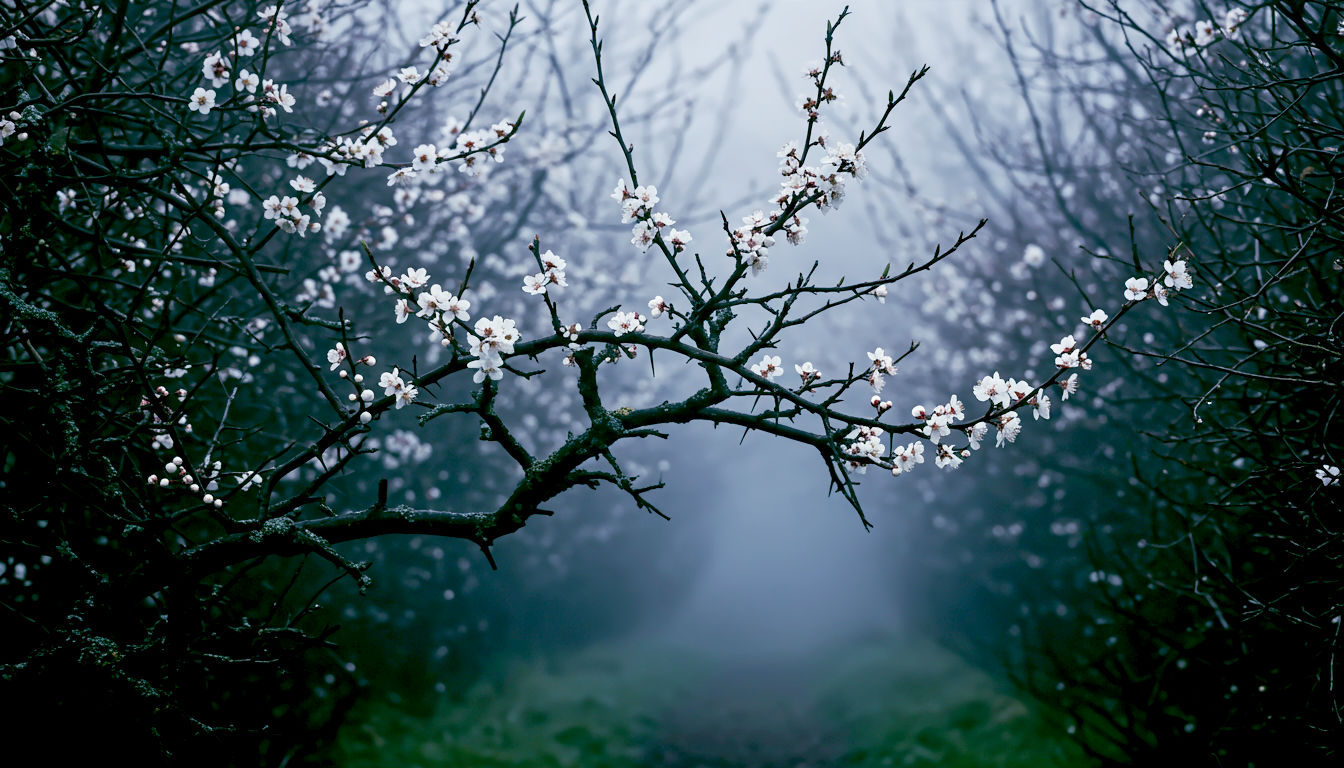
What is it?
Blackthorn is a dense, thorny, deciduous shrub. It’s one of the very first to flower, often in March, bursting into a cloud of small, pure white flowers on its bare, blackish stems before the leaves appear. In autumn, it produces its famous fruit: small, round, purple-black berries called sloes. They have a sharp, astringent taste that makes your mouth pucker if you eat them raw.
A Bit of History and Folklore
Blackthorn has a dark and mysterious reputation in folklore. Its vicious thorns were associated with witchcraft and bad luck. It was said that a blackthorn staff could be used as a powerful magical wand.
On a more practical level, its hard, tough wood was used to make walking sticks (a traditional Irish shillelagh is made from blackthorn). But its greatest gift to us is its sloes. After the first frost of autumn has softened them, they are picked to make the classic winter warmer: sloe gin.
How to Grow it in Your Garden
Blackthorn isn’t a plant for a neat, tidy border. It’s best suited to a wilder part of the garden or as part of a mixed native hedge where it will be brilliant for wildlife.
- Best spot: It’s very tough and will grow in most conditions, in sun or partial shade.
- Planting: Plant bare-root plants from November to March as part of a mixed hedge.
- Care: It needs very little care. You can trim it after flowering if you need to keep it in check. Be aware that it can produce suckers (new shoots from the roots), so you may need to remove these to stop it from spreading too far. Its main role in a garden is as a wildlife haven, providing food for caterpillars, nectar for bees, and a safe nesting place for birds thanks to its thorny branches.
And there you have it…
Ten brilliant plants, shrubs, and trees beginning with B. From the stately Beech to the boozy Blackthorn, each one brings its own unique character and charm to a British garden. They show that you don’t need to be exotic or complicated to be beautiful, useful, and loved. So next time you’re planning a new addition to your garden, don’t forget to browse the ‘B’s.
Further Reading
For more detailed information on growing these and other plants, check out these highly respected resources:
- The Royal Horticultural Society (RHS): https://www.rhs.org.uk/
- The Woodland Trust: https://www.woodlandtrust.org.uk/
- BBC Gardeners’ World Magazine: https://www.gardenersworld.com/






